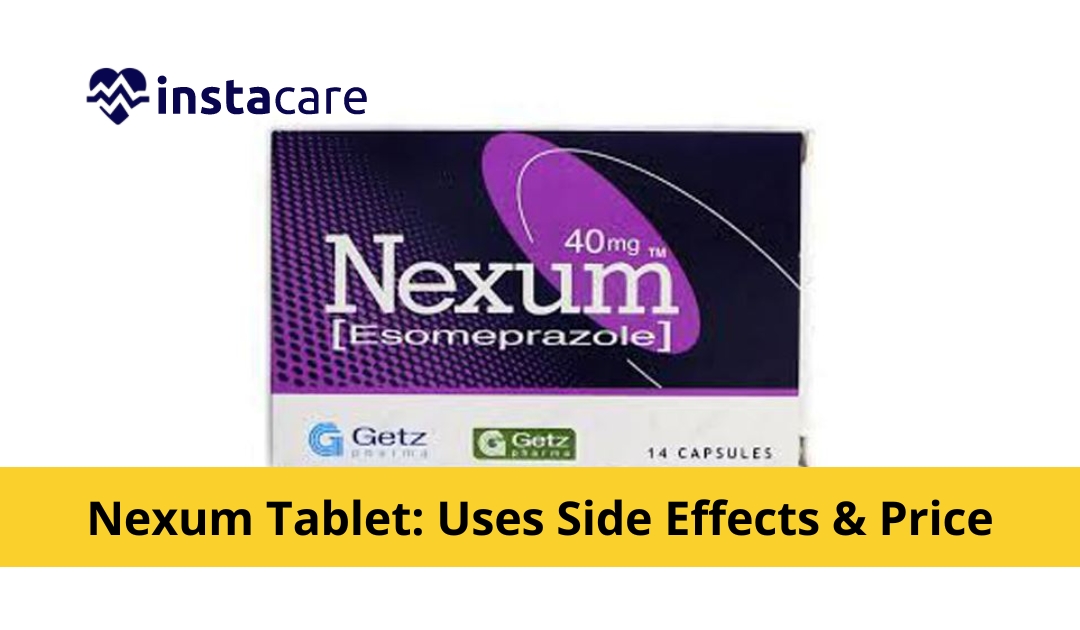Introduction
Nexum a brand name for medication that contains the active ingredient esomeprazole. Esomeprazole belongs to a group of medications called proton pump inhibitors (ppis), which are used to treat conditions that result from too much acid in the stomach.
Uses of nexum tablet
It is used to treat a variety of gastrointestinal conditions that involve excessive production of stomach acid, including:
- Gastroesophageal
reflux disease (gerd): A situation in which stomach acid move back into the
esophagus, begin heartburn, regurgitation, and more indications.
- Peptic ulcer
disease: A condition in which open sores develop in the lining of the stomach
or duodenum, typically caused by a bacterial infection or long-term use of
nonsteroidal anti-inflammatory drugs (nsaids).
- Zollinger-ellison syndrome: A rare condition in which a tumor in the pancreas or duodenum causes excessive production of stomach acid.
- Dyspepsia: A general term for stomach discomfort, such as bloating, indigestion, and nausea.
View More: Digestine Tablet - Uses Side Effects And Price in Pakistan
Disease interactions
Here are
some of the notable interactions of nexum with other diseases,
- Liver
disease: patients with liver disease may require a lower dose of nexum or may
not be able to take it at all. Patients with liver disease should consult their
healthcare provider before taking nexium.
- Osteoporosis:
long-term use of nexum may increase the risk of fractures, particularly in
patients with osteoporosis. Patients with osteoporosis should be monitored
closely while taking nexum.
- Hypomagnesemia:
nexum may decrease magnesium levels in the body, which can lead to
hypomagnesemia. Patients with low magnesium levels or taking medications that
can cause hypomagnesemia should be monitored closely while taking nexum.
Food interactions
There are
certain foods and beverages that may worsen symptoms of gastroesophageal reflux
disease (gerd) and peptic ulcers, which are the conditions commonly treated
with nexum. These include:
- Spicy foods:
spicy foods can increase stomach acid production and worsen symptoms of gerd
and peptic ulcers.
- Acidic
foods: foods such as citrus fruits, tomatoes, and vinegar can also increase
stomach acid production and worsen symptoms.
- Caffeine:
beverages such as coffee, tea, and cola can increase stomach acid production
and worsen symptoms.
- Alcohol:
alcohol can irritate the lining of the stomach and increase acid production,
worsening symptoms.
- Fatty and
fried foods: these foods can slow down digestion and increase the risk of acid
reflux and gerd symptoms.
Side effects of
The most
usual side effects of nexum include:
- Headache
- Nausea
- Diarrhea
- Abdominal
pain
- Constipation
- Dry mouth
- Flatulence
- Dizziness
Less usual
but more complicated side effects of nexum include:
- Hypersensitivity
reactions, such as rash, hives, or difficult respire
- Inflammation
of the face, lips, tongue, or gullet
- Severe
stomach ache or diarrhea
- Bone fractures,
particularly in the hip, wrist, or spine
- Low
magnesium levels in the blood, which can lead to muscle spasms, irregular
heartbeat, and seizures
- Highest risk
of bacterial contamination, acting as pneumonia
- Highest risk
of clostridium difficile infection, which can origin heavy diarrhea and colitis
Dosing information
The dosing
of nexum (esomeprazole) depends on the condition being treated, the severity of
symptoms, and the patient's medical history. It is important to follow the
dosing instructions provided by your healthcare provider or the medication
label. The following is a general guideline for nexium dosing:
- Gastroesophageal
reflux disease (gerd)
- Adults: the
usual dose is 20-40 mg once daily for 4-8 weeks.
- Children:
the dose is based on weight and is usually 10-20 mg once daily for up to 8
weeks.
- Peptic
ulcers
- Adults: the
usual dose is 20-40 mg once daily for 4-8 weeks.
- Children:
the dose is based on weight and is usually 10-20 mg once daily for up to 8
weeks.
- Zollinger-ellison
syndrome
- Adults: the
usual starting dose is 40 mg twice daily, which can be increased to up to 240
mg daily based on response.
- H. Pylori
eradication
- Adults: the
usual dose is 20-40 mg twice daily in combination with antibiotics for 7-14
days.
Dosage form
Nexum is available as a tablet, capsule, or oral suspension. The medication can be taken with or without food, but it is recommended to take it at least one hour before a meal. Patients should not crush or chew the tablets, and the oral suspension should be mixed with water before use.
View More: Bromalex Tablet - Uses Side Effects and Price in Pakistan
Storage
- Nexum
(esomeprazole) should be stored at room temperature between 68-77 degrees
fahrenheit (20-25 degrees celsius) in a dry place, away from moisture and
direct sunlight. The medication must be keep away from the reach of children.
- Nexum tablets should be kept in their original blister pack until ready to use. The blister pack should be opened just before taking the medication.
Packaging
- Nexum
(esomeprazole) tablets are typically packaged in a blister pack, which is a
form of packaging that consists of a plastic sheet with individual compartments
for each tablet. The blister pack is designed to safeguard the medication from
wetness, light, and air, which can affect the stability of the medication.
- The blister pack is typically enclosed in a cardboard box, which contains information about the medication, such as the dosage, indications, side effects, and precautions. The packaging also incorporates the expiration date, lot number, and manufacturer information.

